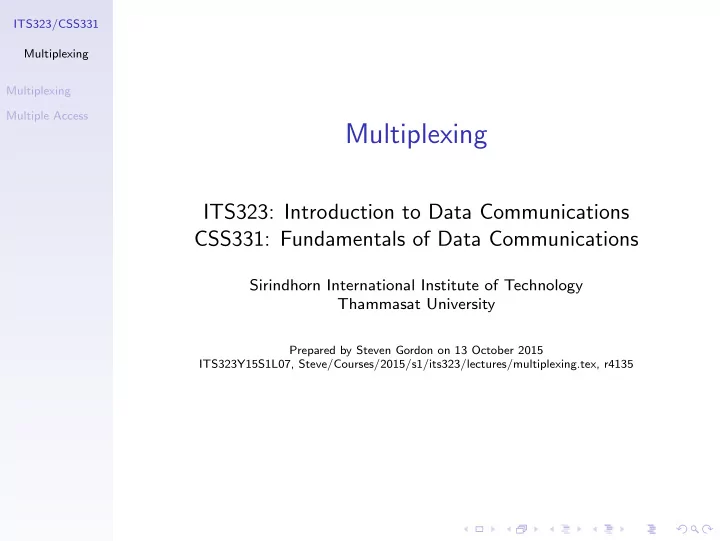

ITS323/CSS331 Multiplexing Multiplexing Multiple Access Multiplexing ITS323: Introduction to Data Communications CSS331: Fundamentals of Data Communications Sirindhorn International Institute of Technology Thammasat University Prepared by Steven Gordon on 13 October 2015 ITS323Y15S1L07, Steve/Courses/2015/s1/its323/lectures/multiplexing.tex, r4135
ITS323/CSS331 Contents Multiplexing Multiplexing Multiple Access Multiplexing Multiple Access
ITS323/CSS331 Supporting Multiple Users Multiplexing ◮ Multiple users in one location want to communicate Multiplexing with multiple users in another location Multiple Access ◮ Option 1: one link (line) per pair of users ◮ Each user has dedicated link, no interference ◮ Wasteful of resources; hard to expand B freq f1 srcA dstA B freq f1 srcB dstB B freq f1 srcC dstC B freq f1 srcD dstD
ITS323/CSS331 Multiplexing Multiplexing ◮ A single line connects two locations via special devices Multiplexing ◮ Multiplexer (MUX) combines signals from each source Multiple Access user, and transmits one signal ◮ Demultiplexer (DEMUX) splits received signal into separate signals and sends to destination users ◮ How to combine signals from multiple users? srcA dstA srcB dstB MUX DEMUX srcC dstC srcD dstD
ITS323/CSS331 Frequency Division Multiplexing Multiplexing ◮ Signals from each user are transmitted at same time, Multiplexing but different frequencies Multiple Access Bandwidth > 4B srcA dstA B B B B f1 f2 f3 f4 freq srcB dstB MUX DEMUX srcC dstC srcD dstD
ITS323/CSS331 Frequency Division Multiplexing Multiplexing ◮ FDM possible when useful bandwidth of medium Multiplexing exceeds required bandwidth of signals Multiple Access ◮ Each signal modulated onto different carrier frequency, sufficiently separated so signals do not overlap
ITS323/CSS331 Time Division Multiplexing Multiplexing ◮ Signals from each user are transmitted on same Multiplexing frequency, but at different times Multiple Access srcA dstA B f1 freq srcB dstB MUX DEMUX srcC dstC srcD dstD t1 t2 t3 t4 t5 time
ITS323/CSS331 Time Division Multiplexing Multiplexing ◮ Multiple digital signals carried on single transmission Multiplexing path by transmitting portions of each signal one at a Multiple Access time ◮ Synchronous TDM ◮ Statistical TDM
ITS323/CSS331 Example Multiplexing Technologies Multiplexing FDM Multiplexing Multiple Access ◮ Broadcast and cable TV, radio ◮ Long-distance carrier system deployed by telecom operators ◮ Optical fibre: Wavelength Division Multiplexing ◮ ADSL TDM ◮ Digital carrier systems to replace FDM carrier systems (T-hierarchy, PDH) ◮ SONET/SDH
ITS323/CSS331 FDM Example: ADSL Multiplexing ◮ Plain Old Telephone Service (POTS), voice calls: 0—20 Multiplexing kHz Multiple Access ◮ Uplink data to ISP: 25—200 kHz ◮ Downlink data from ISP: 250—1000 kHz
ITS323/CSS331 TDM Example: SONET/SDH Signal Hierarchy Multiplexing ◮ PDH (T1, T2, E1, . . . ) used electrical digital signals for Multiplexing connections between buildings, cities, countries: upto Multiple Access about 500 Mb/s ◮ Gradually replaced with SONET (US) and SDH (rest of world), which uses optical carrier (OC) signals
ITS323/CSS331 Contents Multiplexing Multiplexing Multiple Access Multiplexing Multiple Access
ITS323/CSS331 Supporting Multiple Users in Point-to-Multipoint Multiplexing Links Multiplexing ◮ Multiple users share a point-to-multipoint link Multiple Access ◮ Typical for wireless systems (WiFi, mobile phone) and some wired LANs ◮ Use multiple access schemes to determine who transmits and when
ITS323/CSS331 Multiple Access: Fixed Assignment Multiplexing A fixed assignment of transmission opportunities to users Multiplexing based on: Multiple Access ◮ Frequency Division Multiple Access (FDMA): users are assigned frequencies; transmit at same time ◮ Time Division Multiple Access (TDMA): users are assigned time slots; transmit on same frequency ◮ Code Division Multiple Access (CDMA): users are assigned codes, that allow receive to “separate” signals; transmit on same frequency, at same time ◮ Space Division Multiple Access (SDMA): transmissions in different physical areas, e.g. using directional antennas
ITS323/CSS331 Multiple Access: Demand Assignment Multiplexing Transmission opportunities are assigned to users on-demand: Multiplexing Multiple Access ◮ Reservation-based: users are assigned schedule of transmissions based on earlier reservations; use FDMA, TDMA, CDMA, SDMA ◮ Polling-based: users are asked if they want to transmit
ITS323/CSS331 Multiple Access: Random Access Multiplexing ◮ Users transmit when desired, but after some random Multiplexing waiting time and as long as no-one else is transmitting Multiple Access ◮ The user that selects the smallest random waiting time will get to transmit first (and others will wait until they finish) ◮ Simple, can operate in distributed manner ◮ Used in wireless LANs (WiFi)
Recommend
More recommend